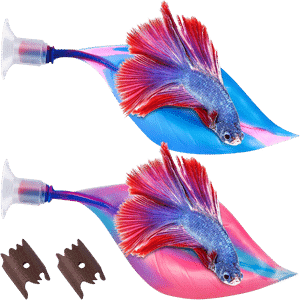21 Best Betta Tank Mates
Welcom to our blog post about the best Betta tank mates for a community tank
Betta fish have often been the center of attention in many aquarium setups. Popularly known as the “Siamese Fighting Fish,” they’ve earned a reputation as solitary warriors, often preferring to swim solo rather than share their space.
However, contrary to popular belief, bettas don’t always have to lead a life of splendid isolation. With the right tank mates and fish tank size, your betta can thrive in a lively community setting.
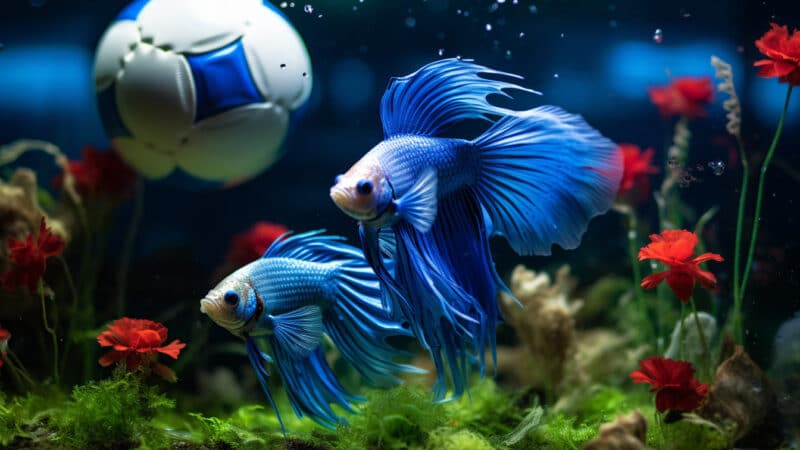
Introducing compatible companions not only brings out the best in your betta but also adds layers of depth, color, and interaction to your aquarium, transforming it into a bustling underwater metropolis.
Let’s dive into the mesmerizing world of betta community tanks and explore how even the fiercest fighters can enjoy some friendly neighbors.
Table of Contents 🦑
Understanding Betta Fish Behavior
Betta fish are unique and enchanting creatures, but their behavior can sometimes be quite challenging to new aquarium enthusiasts. To successfully introduce new tank mates, it’s essential to grasp the intricacies of betta behavior.
Territorial by Nature: Betta fish are fiercely territorial. Originating from the shallow waters and rice paddies of Thailand and Cambodia, they’ve evolved in environments where space was limited. Consequently, male bettas, in particular, developed a strong instinct to protect their claimed territory. They often view other fish, especially those with similar appearances, as threats, leading them to defend their territory vigorously.
Signs of Aggression: While flaring fins might make for a captivating display, it’s a classic sign of a betta feeling threatened. Other indicators include chasing, nipping at fins, and an overly upright swim posture. When you notice these behaviors, it’s not merely a show your betta is signaling its distress or asserting dominance.
Impact on Tank Mates: This aggressive tendency doesn’t mean bettas can’t have tank mates. It means that the choice of companions is crucial. Fish that are too colorful, too large, or have long, flowing fins can be perceived as rivals, leading to constant skirmishes. Conversely, fish that are too small or slow might become easy targets for a frustrated betta.
The key is balance. By understanding the betta’s natural behavior and tendencies, you can select tank mates that coexist harmoniously, ensuring a peaceful and vibrant aquarium environment.
Silicone Betta bed leaves are designed to mimic the natural environment of Betta fish, offering them a place to rest and hide near the surface of the water.
21 Best Tank Mates for Bettas
Here is a list of 21 best companions for your betta friend, each chosen for their compatibility, charm, and unique attributes.
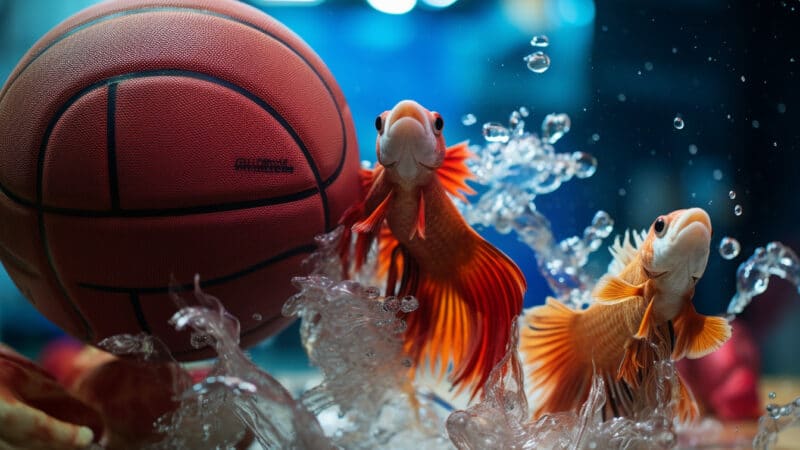
Small and peaceful Fish Betta Tank Mates
Neon Tetras
Neon tetras are known for their vibrant blue and red coloration, which can create a stunning contrast with bettas. Originating from South American waters, they prefer slightly acidic environments. They are schooling fish, so it’s best to keep them in groups of at least six.
Reasons: Their fast-swimming nature allows them to evade bettas. Their non-aggressive demeanor means they won’t provoke the betta, and they inhabit different tank regions (middle zone) than bettas, reducing territorial disputes.
Ember Tetras
These are bright orange, tiny fish that school together. They hail from Brazil and are like densely planted tanks. Their small size makes them less threatening to bettas.
Reasons: Their diminutive size makes them a non-threat, and their calm nature avoids triggering any aggressive betta behavior.
Rummy-nose Tetra
Named for their distinctive red noses, they also have a beautiful tail pattern. Originating from South America, they’re schooling fish, often swimming in tight groups.
Reasons: Their schooling behavior and distinct colors make them attractive, yet non-confrontational companions.
Harlequin Rasboras
Recognized for their orange bodies with a black patch towards the tail, these fish are native to Malaysia. They are community-friendly, enjoying the company of other peaceful fish.
Reasons: Their peaceful temperament and tendency to school together keep them from being seen as threats by bettas.
Endler's Livebearers
With captivating patterns and colors, these fish come from Venezuela’s warm waters. They’re active, which can be both entertaining and a deterrent for curious bettas.
Reasons: Their vibrant appearance adds contrast without provoking bettas, and they usually stick together, avoiding any territorial incursions.
Pygmy Corydoras
Native to South American rivers, these are tiny catfish that often scavenge the bottom for food. Their armored bodies provide some protection against potential nips from other fish.
Reasons: They scavenge at the tank bottom, a region bettas rarely frequent, thus minimizing any potential conflicts.
White Cloud Minnows
Originating from China, these are cold-water fish. They are hardy and have a shimmering appearance with red-tipped fins.
Reasons: Their swift nature keeps them safe, and their top-dwelling habits avoid territorial disputes.
Guppies
Known for their flamboyant tails, they can be found in various patterns and colors. They’re livebearers, so tank owners might find baby guppies if conditions are right!
Reasons: While colorful, they are quick swimmers, and as long as their fins aren’t too flashy, they can coexist with bettas.
Feeder Guppies
Typically used as food for larger fish, they are more simply colored than fancy guppies. They’re hardy and can be an economical addition to the tank.
Reasons: Their plain appearance and quick movements keep them safe from Betta’s attention.
Mollies
With a variety of colors and fin types available, they are livebearers and can adapt to both freshwater and brackish conditions. Native to the Americas, they’re active and can occasionally show semi-aggressive tendencies.
- Reasons: While active, they usually avoid confrontation with bettas, especially in spacious tanks.
Invertebrates Betta Tank Mates
Ghost Shrimp
These translucent shrimp can be fascinating to watch as you can see their internal organs! They’re excellent scavengers, helping keep the tank clean.
Reasons: Their translucent bodies often go unnoticed by bettas. Additionally, their scavenger nature helps maintain tank cleanliness.
Amano Shrimp
Originating from Japan, these shrimp are larger and have a speckled appearance. They’re lauded by aquarium enthusiasts for their exceptional ability to control algae.
Reasons: Their larger size prevents them from becoming betta snacks. Also, their proactive algae-eating habits keep the tank pristine.
Nerite Snails
These snails come in various patterns and colors, adding diversity to the tank. They hail from coastal areas, thriving in both freshwater and slightly brackish conditions.
Reasons: Their hard shell protects them from curious bettas, and their diverse patterns add aesthetic appeal.
Mystery Snails
Available in numerous colors, from golden to blue, they can be intriguing to watch as they move around the tank, munching on algae.
Reasons: Their leisurely pace and hard exterior make them resistant to betta curiosity, while they contribute to algae control.
Thai Micro Crabs
Extremely small and delicate, these crabs are filter feeders. Native to Thailand, they prefer a gentle current to mimic their riverine habitat.
Reasons: Their minuscule size and tendency to hide reduces chances of conflict with bettas.
Algae Eaters Betta Tank Mates
Otocinclus Catfish
Often termed “dwarf suckers” or “otos”, they originate from South America. They are diligent algae eaters, often seen clinging to tank surfaces.
Reasons: Their non-intrusive nature and focus on algae consumption keep them out of betta’s way.
Bristlenose Plecos
A smaller variant of the typical Suckermouth catfish, they have tentacle-like structures on their noses. Native to South American rivers, they appreciate driftwood in their habitat.
Reasons: Their larger size and nocturnal habits mean limited interaction with bettas, and they contribute to tank cleanliness.
Other Friendly Betta Tank Mates
African Dwarf Frogs
These fully aquatic frogs are entertaining, often seen floating motionlessly or darting for air. They have a peaceful temperament and can be a unique addition to a community tank.
Reasons: Being fully aquatic and residing at the bottom, their paths rarely cross with bettas. Their quirky behavior also provides entertainment.
Kuhli Loaches
Eel-like in appearance, these nocturnal creatures are native to Southeast Asia. They like burrowing and will need a soft substrate.
Reasons: Their nocturnal lifestyle and love for burrowing keep them safe from bettas during the day.
Cherry Barb
Native to Sri Lanka, these fish have a reddish hue, especially the males. They’re peaceful by nature and prefer a planted environment.
Reasons: Their calm disposition and tendency to school make them unlikely targets for betta aggression.
Platy
Native to Central America, they come in a myriad of colors. Another livebearer, they can be quite active and add vibrancy to the tank.
Reasons: Their active nature and non-aggressive temperament make them good companions, provided they have enough space.
With proper research and care, all these species can make wonderful tank mates for bettas, enhancing the aesthetics and dynamics of the aquarium.
Criteria for Selecting Betta Tank Mates
Choosing the right companions for your betta fish is akin to matchmaking, it’s all about finding the perfect balance that ensures harmony in your watery palace. But how does one decide which aquatic species fit the bill? Here are the vital criteria you need to consider:
1. Size and Temperament Compatibility:
Size Matters: The ideal Betta tank mates should neither be too large nor too small compared to your betta. Larger fish might bully or intimidate your betta, while smaller ones could become an unintended snack.
The Right Temperament: Passive and non-aggressive fish are generally the best choices. Avoid species known for nipping fins, as bettas have delicate, flowing tails that can be tempting to such species. Conversely, steer clear of fish that are too shy or slow-moving, as they could get stressed by a betta’s active demeanor.
2. Habitat Requirements:
Vertical vs. Horizontal Swimmers: Betta fish tend to be surface dwellers, often seen gracefully gliding near the water’s surface. To reduce competition for space, consider choosing Betta tank mates that prefer the middle or bottom parts of the tank.
Water Conditions: While bettas can tolerate a variety of water conditions, it’s important to ensure that their tank mates have similar preferences. Look for species that thrive in similar pH, temperature, and hardness levels. This ensures that when you adjust the water conditions to suit your betta, the tank mates remain comfortable as well.
In essence, understanding these criteria ensures not only the well-being of your betta but also the overall health and happiness of the entire aquarium community. It’s about creating a cohesive, balanced environment where every fish feels at home.
Avoiding Incompatible Companions for Your Betta Fish
When considering tank mates for your betta fish, there are certain aquatic animals you should be cautious of or avoid entirely. Here’s a list of such species and the reasons why:
Other Bettas (especially males): Male bettas are highly territorial and will fight with other males, often to the death. Even female bettas can be aggressive toward one another, though it’s possible to keep a group of females together in a sorority tank with careful monitoring.
Gouramis: Gouramis and bettas are from the same family and share similar territorial behaviors. Their coexistence could lead to confrontations.
Fin-nipping species (like Tiger Barbs, Serpae Tetras): These species tend to nip at the betta’s long, flowing fins, causing stress and potential injury.
Larger, aggressive fish (like Cichlids, Oscars): Such species can view the betta as prey or a rival, leading to potential harm or death.
Brightly colored or long-finned fish: These fish might be mistaken for rival male bettas, provoking aggressive behavior.
Territorial bottom dwellers (like Red-tailed Sharks, some Plecos): They can become aggressive if they feel their territory is being invaded.
Fast or aggressive feeders: Fish that are quick to the food can out-compete bettas during feeding times, leaving your betta without enough food.
Very active swimmers: Species that are too active can stress bettas out, as bettas prefer more tranquil environments.
Fish requiring different water conditions: Bettas thrive in warmer waters (around 76-82°F or 24-28°C). Fish requiring cooler or vastly different water parameters might not be suitable as tank mates.
Large invertebrates (like big crayfish, larger crabs): These might see the betta as a potential meal or can be aggressive.
While the above list provides a general guideline, the specific dynamics can vary based on the individual temperament of your betta, the tank size, setup, and other factors. Always monitor new additions for signs of aggression or stress, and be prepared to separate or rehome fish if necessary.
Can Male and Females Bettas Live Together?
Keeping male and female betta fish together in the same tank is generally not recommended for several reasons:
Aggression: Male bettas are known for their aggression, not just towards other males but also towards females. This aggression can lead to fights, causing potential injury or death to either fish.
Breeding Behavior: If male and female bettas are kept together, they might attempt to breed. While this might seem like a good thing, the breeding process for bettas can be violent. The male may become extremely aggressive towards the female, sometimes leading to the female’s injury or death if she’s not removed promptly after spawning.
Stress: Constant pursuit by a male can stress a female, affecting her health and well-being. Stress can weaken the immune system, making the fish more susceptible to diseases.
Territorial Disputes: Both male and female bettas are territorial. Even if they aren’t displaying outright aggression, they might still chase each other around, leading to stress.
However, under controlled conditions and for short periods, male and female bettas can be introduced for breeding purposes. Professional breeders usually have separate tanks and only introduce the fish under careful supervision. After spawning, they’re separated again to prevent any harm.
In summary, for the well-being of both fish, it’s best to keep male and female bettas in separate tanks. If you’re interested in breeding bettas, it’s essential to research and understand the process thoroughly before attempting it.
Can Female Bettas Live Together?
Yes, female bettas can live together under certain conditions, in what is commonly referred to as a “sorority tank.” Here’s a quick overview:
Female Bettas Sororities Tank
Female bettas, unlike their male counterparts, can coexist in the same tank without exhibiting the same degree of aggression. However, this doesn’t mean they’re always peaceful. They can and often do establish a pecking order, and some aggression can be observed as they establish and maintain this hierarchy.
Important Considerations:
Tank Size: A larger tank is essential when setting up a sorority, with a recommended size of at least 20 gallons or more. This ensures each betta has enough space to establish her own territory.
Number of Females: It’s generally recommended to keep at least five female bettas together. Odd numbers are preferred, as this helps distribute aggression and prevents bullying of a single fish.
Decor and Plants: A well-decorated tank with plenty of hiding spots, plants, and caves can reduce visible lines of sight and allow females to escape if they’re being chased.
Monitor Aggression: It’s crucial to monitor aggression levels, especially when first introducing the bettas to the tank. If a particular fish is too aggressive, it may need to be isolated or rehomed.
Quarantine New Additions: Before adding new females to an established sorority, it’s a good practice to quarantine them to ensure they don’t introduce diseases to the main tank.
In conclusion, while female bettas can live together, it’s essential to be well-informed and prepared to manage potential challenges. Proper setup and close monitoring can lead to a successful betta sorority tank.
How To Minimize The Chances of Betta Fish Aggression?
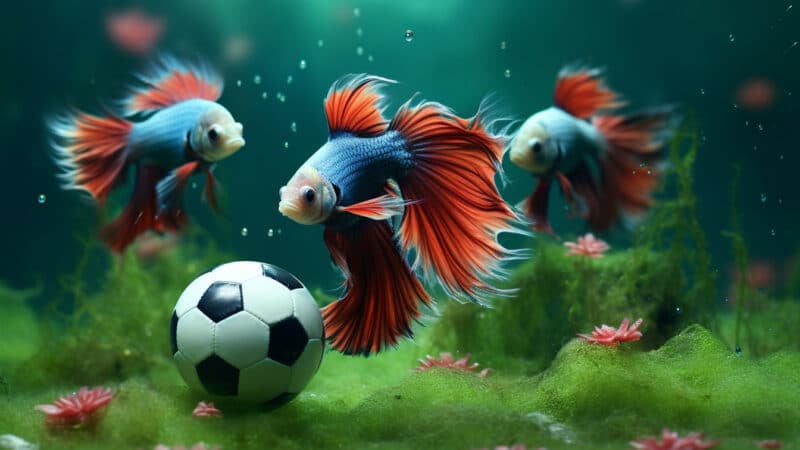
Minimizing betta aggression is crucial for the well-being of both the betta and its potential tank mates. Here’s how to mitigate aggressive behavior in bettas:
Adequate Tank Size: A spacious environment allows fish to establish their own territories without feeling threatened. A larger tank also provides more swimming and hiding space, reducing stress and potential confrontations.
Provide Hiding Spots: Use plants, caves, rocks, and driftwood to create numerous hiding spots and barriers in the tank. These act as visual breaks and can prevent prolonged aggressive confrontations.
Choose the Right Betta Tank Mates: Opt for peaceful, non-aggressive species that don’t resemble bettas in appearance. Avoid colorful or long-finned fish that the betta might mistake for a rival.
Monitor During Feedings: Aggression can spike during feeding times. Ensure that all fish get their share of food, and consider feeding the betta separately if it becomes too aggressive.
Gradual Introductions: When introducing new fish, it’s beneficial to rearrange the tank’s decorations. This disrupts established territories and makes the environment new for all fish. Also, using a quarantine or isolation tank can help new fish acclimate and reduce stress when introduced to the main tank.
Keep Bettas Well-Fed: A well-fed betta is less likely to be aggressive. However, avoid overfeeding, as this can lead to health issues and reduced water quality.
Watch for Signs of Stress: Clamped fins, rapid breathing, and darting around the tank can be signs your betta is stressed. Monitoring behavior can help you address potential issues before they escalate.
Use a Tank Divider: If aggression continues, consider using a tank divider to separate the betta from other fish. This allows them to coexist in the same water without physical interaction.
Maintain Stable Water Conditions: Stress from poor water quality can increase aggression. Regularly test the water and maintain stable temperature, pH, and ammonia/nitrite/nitrate levels.
Consider the Betta’s Individual Personality: Remember, every betta has a unique temperament. Some may tolerate tank mates well, while others may not, regardless of the environment. Always be prepared to make adjustments based on the individual needs and behaviors of your fish.
In conclusion, while bettas are known for their territorial nature, with proper care, attention, and environment management, it’s possible to reduce aggressive tendencies and help them coexist peacefully with other tank inhabitants.
Things to Consider When Introducing New Tank Mates for Betta Tank
Introducing new tank mates to your betta’s environment is an exciting venture, but it requires preparation, patience, and close observation. Ensuring a smooth transition is essential for the health and harmony of your aquatic community. Let’s delve into some vital considerations for this process:
1. Properly Acclimating New Fish:
Bag Floating: When you bring your new tank mates home, they’re typically in a bag of water. Float this sealed bag on the surface of your aquarium for about 15-20 minutes. This allows the water inside the bag to gradually match the temperature of your tank, reducing the shock for the new inhabitants.
Drip Acclimation: After temperature acclimation, consider using the drip method, especially if the water parameters (like pH) of your tank and the bag differ. Set up a siphon using airline tubing, letting water drip from your tank into a bucket containing the new fish. Over an hour or so, this slowly adjusts the fish to your tank’s specific conditions.
2. Monitoring for Signs of Aggression or Stress:
First Impressions: The initial moments can be crucial. Watch closely as new tank mates get to know each other. It’s normal to see some curiosity or mild flaring, but prolonged aggression requires intervention.
Signs to Watch For: Aggressive chasing, nipping, or cornering are red flags. On the other hand, if a fish is hiding incessantly, breathing rapidly, or showing faded colors, it might be stressed.
Intervention: If you see aggressive behavior, consider using a tank divider or a separate quarantine tank temporarily. This gives your betta and the new tank mate some time to adjust to each other’s presence without direct contact.
3. Benefits of Planted Tanks and Hiding Spots:
Natural Barriers: Plants act as natural dividers, breaking the line of sight and reducing potential territorial disputes. They also provide shaded areas, making your fish feel more secure.
Enhancing Exploration: Diverse environments with plants and decorations encourage exploration and play. It’s a treat watching your betta and its great tank mates weave through aquatic plants or peek out from hiding spots.
In summary, introducing new tank mates to your betta requires a thoughtful approach. The key is to ensure gradual acclimation, provide a rich environment with hiding spots, and monitor interactions closely. With care and patience, your aquarium can become a harmonious community where each member thrives.
The Minimum and Optimal Tank Size for Betta Fish With Tank Mates
Betta fish can thrive in tanks of various sizes, but when adding tank mates, it’s essential to consider both the minimum and optimal tank sizes to ensure the well-being of all inhabitants.
Minimum Tank Size for a Betta with Tank Mates:
5 Gallons: This is the absolute minimum for a betta with very few small tank mates like snails or shrimp. However, the possibilities for adding other fish are extremely limited in this size.
Optimal Tank Sizes for Betta with Tank Mates:
10 Gallons: A 10-gallon tank offers more options. You can include some small, peaceful fish like neon tetras or pygmy corydoras. There’s also room for a few invertebrates.
20 Gallons: With a 20-gallon tank, your options expand significantly. You can establish a more diverse community of small to medium-sized peaceful fish, snails, and shrimp. Bristlenose plecos, which require more space, become a viable option in tanks of this size or larger.
30 Gallons and Above: Larger tanks allow for a more extensive range of Betta tank mates, including schooling fish and multiple species. They also make it easier to maintain stable water parameters and offer bettas and their companions ample space to explore, hide, and establish territories.
Important Considerations:
Territorial Needs: Even in larger tanks, it’s essential to monitor bettas for signs of stress or aggression towards tank mates. Some bettas prefer solitude regardless of tank size.
Water Parameters: Larger volumes of water can more easily dilute waste products, making water quality more stable. Regular water testing and maintenance are still essential.
Hiding Spots: Regardless of tank size, it’s crucial to provide plenty of hiding spots, especially when introducing new fish or invertebrates. This can reduce stress and aggression.
Filtration: As you increase the number of tank inhabitants, efficient filtration becomes even more crucial to handle the increased bioload.
In conclusion, while it’s possible to keep a betta fish with tank mates in smaller tanks, optimal sizes of 20 gallons or more provide a healthier environment, more stability, and a broader range of potential companions.
The Best Water Parameters for Betta Fish Tank With Tank Mates
For a betta fish tank with tank mates, maintaining the right water parameters is essential to ensure the health and well-being of all the inhabitants. Here are the ideal water parameters for a betta fish tank with companions:
Temperature: Bettas thrive in warm water. The ideal temperature range for bettas and most of their compatible tank mates is between 76°F to 82°F (24°C to 28°C). Ensure you have a reliable heater and thermometer to monitor and maintain this range.
pH Level: Bettas prefer slightly acidic to neutral water. Aim for a pH level between 6.5 and 7.5. It’s essential to regularly test the pH and ensure it remains stable, as sudden fluctuations can be harmful.
Hardness: Soft to moderately hard water is suitable for bettas. The general hardness (GH) should be between 3 to 12 dGH. The carbonate hardness (KH) can be kept between 3 to 8 dKH.
Ammonia, Nitrite, and Nitrate: In any aquarium, the levels of ammonia and nitrite should always be at 0 ppm, as even small amounts can be harmful. Nitrate is less toxic than ammonia and nitrite, but high levels indicate poor water quality. Aim to keep nitrate levels below 20 ppm, with levels below 10 ppm being even better. Regular water changes and a well-functioning biological filter will help maintain these parameters.
Dissolved Oxygen: While bettas can breathe atmospheric air using their labyrinth organ, their tank mates rely on dissolved oxygen in the water. Ensuring good water circulation and aeration will help maintain adequate oxygen levels.
Chlorine and Chloramines: Tap water often contains chlorine or chloramines, which are harmful to fish. Always use a water conditioner when adding fresh water to the tank to neutralize these substances.
Tips for Maintaining Optimal Water Parameters:
Regular Testing: Invest in a good quality aquarium test kit to monitor pH, ammonia, nitrites, nitrates, and hardness. Regular testing helps you catch and address potential issues before they become problematic.
Consistent Water Changes: Weekly water changes (typically 25-30% of the tank volume) help dilute waste products and replenish essential minerals.
Adequate Filtration: Ensure your filter is appropriate for the size of your tank and is regularly cleaned and maintained.
Avoid Overfeeding: Excess food decays and can negatively affect water quality.
Adapt for Tank Mates: When choosing tank mates, consider their specific water parameter requirements and ensure they align well with those of bettas.
Remember, while it’s essential to aim for these ideal parameters, consistency is crucial. Rapid changes in water conditions can be more harmful than slightly off parameters. Always make adjustments gradually and monitor your fish for signs of stress or discomfort.
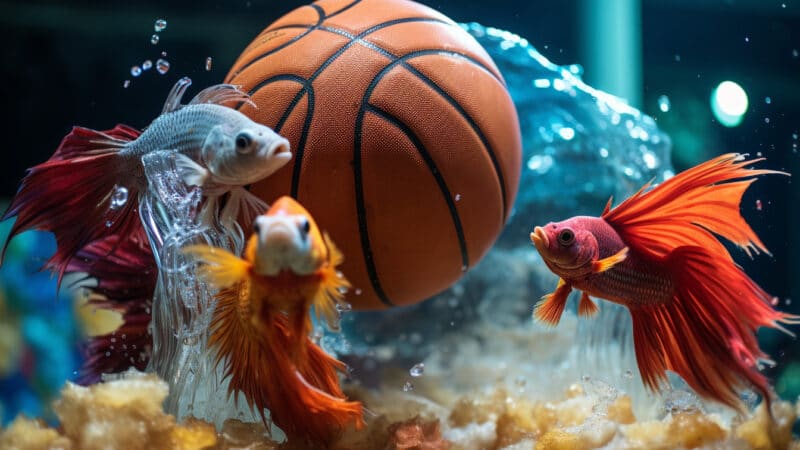
In Conclusion
The journey of creating a vibrant and harmonious aquatic community with your betta fish at its heart can be deeply rewarding. By carefully selecting compatible tank mates, understanding betta behavior, and ensuring a welcoming environment, you pave the way for a thriving underwater world. Remember, the joy lies not just in the destination but also in the thoughtful process of getting there. As you introduce new members to your betta’s world, you’re crafting a dynamic, beautiful, and fascinating ecosystem that promises endless moments of wonder.
Thank you for diving deep with us into the world of betta companionship! Your passion and curiosity for creating the best environment for your finned friends truly warms our hearts. We genuinely appreciate you choosing to journey alongside us, and we’re excited to continue sharing more aquatic insights and stories with you. Here’s to creating bubbles of happiness in your aquarium. Cheers and happy fish-keeping! 🐠🌱🎉

Delighted to have you here at BettaReef! This place is a treasure trove of knowledge about Betta fish, Betta Care, Health, Gear, and much more from the wonders of aquatic life. My journey in this fascinating world began when I was just 8, and now, as a seasoned hobbyist, I’m here to help fellow Betta enthusiasts create a thriving Betta environment for a healthy life.
I’m committed to delivering high-quality content, backed by a stringent editorial process. Each product review is based on real-life usage and practical analysis, ensuring that you get insights and advice that truly matter.
Related Blog Posts:
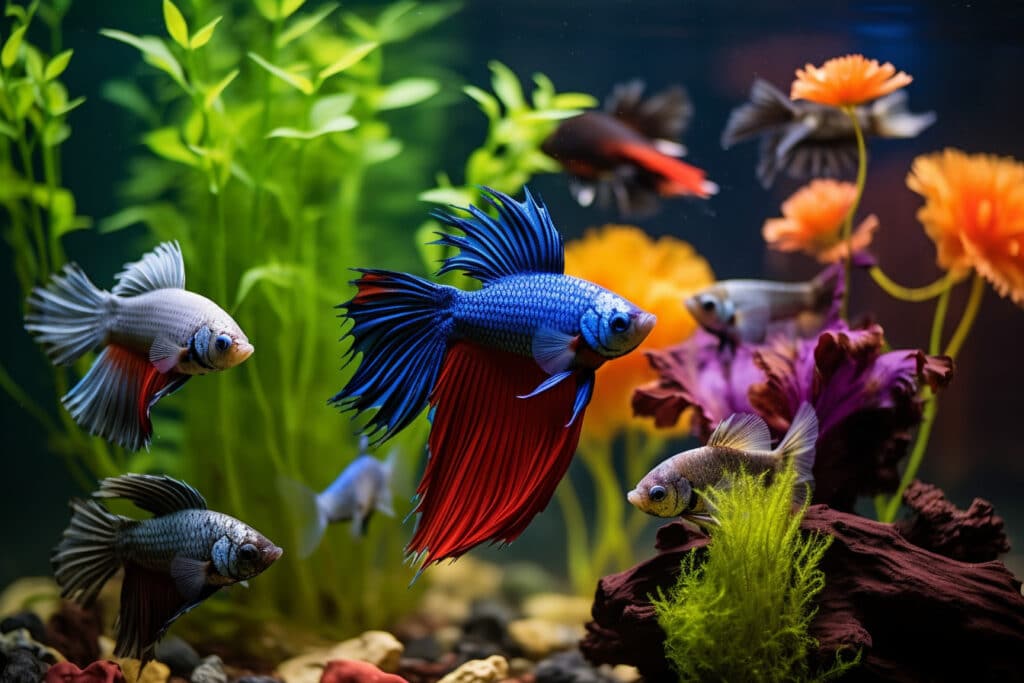
How to Keep a Betta Fish Happy
Swim To 🤿 Home How to Keep a Betta Fish Happy Are you a proud
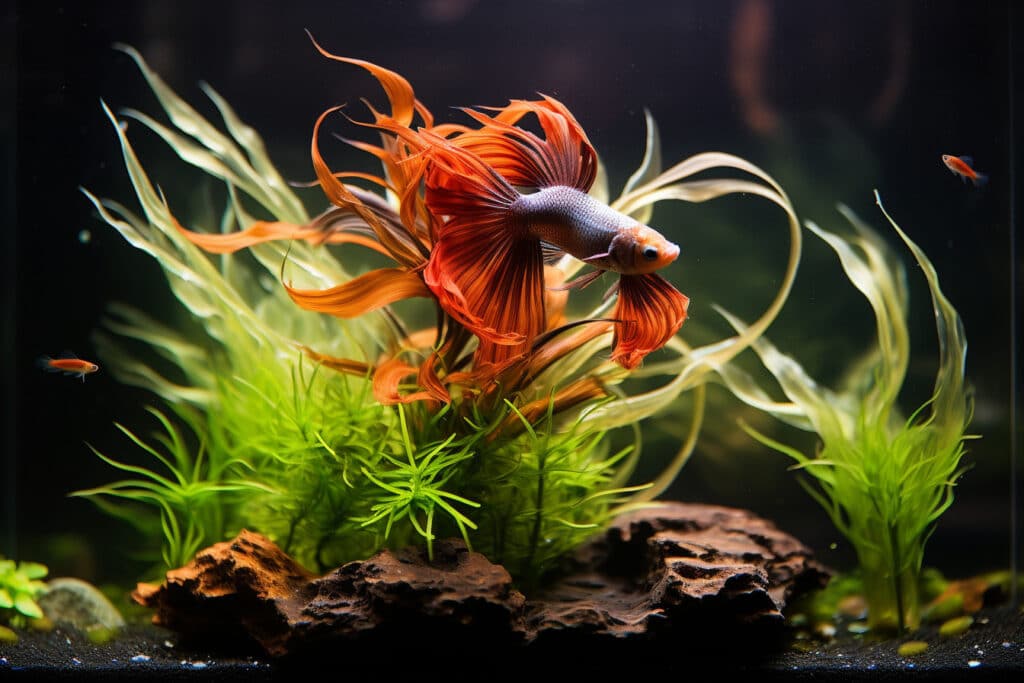
The Best Aquatic Plants For Betta Fish
Home The Best Aquatic Plants For Betta Fish Aquatic Plants for Betta Fish: Uncover the

21 Most Beautiful Types of Betta Fish
Swim To 🤿 Home 21 Most Beautiful Types of Betta Fish Betta fish or Siamese

